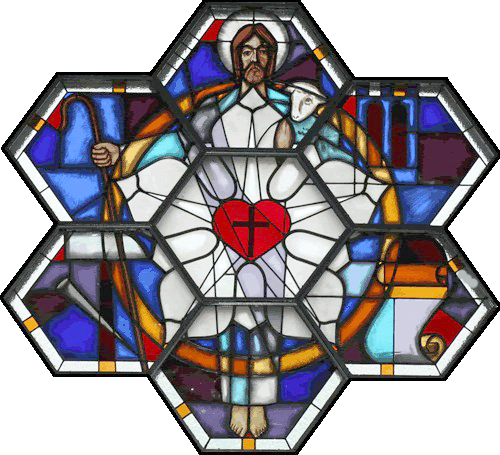The major symbol of the sanctuary window of Good Shepherd Lutheran Church is Martin Luther’s seal. Luther, who developed the seal from his family’s coat of arms, said that the seal summarized his teaching. Luther explained in his letter to the town clerk of Nürnberg:
“First, there was to be a black cross set upon a heart which would have its natural color (red), in order to remind myself that it is faith in Him who was crucified which saves us. For the righteous shall live by faith, namely, by faith in Him who was crucified.” (See Romans 1:17, 3:21-24, 10:8-10).
“The heart is placed on a white rose to show that faith brings forth joy, comfort, and peace. This is why the rose must be white – not red – for white is the color of the blessed and of all angels.” (See Revelation 3:4-5, 6:9-11, 7:9-10, 12-17.)
“This rose should be placed on a field tinted with hues of heaven to signify that the joy and faith of the world to come have already begun to bloom here below.” (See 1 Peter 1:3-7).
“In this field, there is also a gold ring to show that the bliss of heaven endures forever and knows no end, and that its joys and possessions are far above all earthly pleasure, even as gold is the loftiest and most precious of all metals.” (See Matthew 6:19-21, Revelation 22:1-5).
Even though Luther’s seal is central to the window, each section hold its own symbol. Beginning at the top section and moving clockwise:
Head and torso of Jesus, the Good Shepherd, holding to his bosom a small lamb;
Tower of Wittenberg Castle where Luther nailed his 95 Theses – the document that ignited the great Reformation;
Arched door and scroll, representing the 95 Theses and the chapel door to which they were nailed;
Feet of Christ, the Good Shepherd, whose footstool and dominion is all creation;
Hammer and nail by which Luther hung his 95 Theses;
Shepherd’s staff in the right hand of Jesus. As the Good Shepherd, Christ reaches out to gather all who are lost and gone astray.
Revolving around the central panel are expressions of Lutheranism including Luther’s seal, the dramatic events which led to the Reformation and the end of the Dark Age of Christianity, and the Good Shepherd which relates to the humility of Christ and His devotion to His sheep. In like manner, the Church today strives to be a great watchtower with two lancet windows to transmit the light of the World as it was by the revelation of the Old and New Testaments.
At the crown of the tower are three pinnacles representing the triune Godhead – the Father, Son and Holy Spirit. The Church strives as well to be a triumphant arch established to proclaim the true faith of Jesus Christ. Further, the Church strives to be in subjection to Christ, to live at Christ’s feet: “How beautiful are the feet of those who bring Good News” (Romans 10:15).
The Church must continue to forge history and make an impact on the world today; to beat down, as it were, the images of an ungodly society. The Church must have a strong right arm to reach out to fallen humanity. Above all the Church must strive to lift up the headship of Christ – the Christ who surrendered to the will of the Father to die for humanity and all creation. “And I, when I am lifted up from the earth, will draw all people to myself.” (John 12:32)
The window and commentary are provided by the artist who designed it, Peter K. Eichhorn of Louisville, KY. Peter's work is also included in "Remembered Light: Glass Fragments from World War II"
